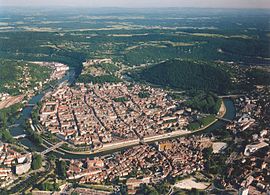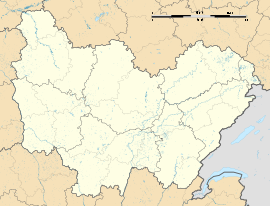Besançon is a city in France. It was the capital of the former Free County (Franche-Comté) region. It is the prefecture of the Doubs department. Its population is around 117,600 (2008).
Besançon | |
|---|---|
 | |
|
| |
| Motto: Plût A Dieu ("If God wills") or Utinam | |
| Coordinates: 47°14′35″N 6°01′19″E / 47.2431°N 6.0219°E | |
| Country | France |
| Region | Bourgogne-Franche-Comté |
| Department | Doubs |
| Intercommunality | Grand Besançon |
| Government | |
| • Mayor (2014–2020) | Jean-Louis Fousseret (PS) |
| Area 1 | 65.05 km2 (25.12 sq mi) |
| • Urban (1999) | 122 km2 (47 sq mi) |
| • Metro (1999) | 1,652 km2 (638 sq mi) |
| Population (2008) | 117,599 |
| • Rank | 29th in France |
| • Density | 1,800/km2 (4,700/sq mi) |
| • Urban (1999) | 134,376 |
| • Urban density | 1,100/km2 (2,900/sq mi) |
| • Metro (1999) | 222,381 |
| • Metro density | 130/km2 (350/sq mi) |
| Time zone | UTC+01:00 (CET) |
| • Summer (DST) | UTC+02:00 (CEST) |
| INSEE/Postal code | 25056 / |
| Website | http://www.besancon.fr/ |
| 1 French Land Register data, which excludes lakes, ponds, glaciers > 1 km2 (0.386 sq mi or 247 acres) and river estuaries. | |
History
changeBesançon is an old city. It is discovered in 58 BC and Julius Caesar writes about it in his book Commentarii de Bello Gallico where it is called Vesontio. The etymology (origin of the word) is not certain. It could have a Celtic origin. The Celtic word wes means mountain. In the 4th century, the letter B became V. The city name changed to Besontio or Bisontion. It became Besançon in 1243. In 1871 the city is going through a revolutionary period, known as Besançon Commune.
The city has a Renaissance citadel. It was later used by the Nazis during World War II.
Climate
changeBesançon has an oceanic climate and a continental climate. The average temperature is 10.2 °C (50 °F). The warmest month of the year is July (18.9 °C or 66 °F) and the coldest month is January (1.6 °C or 35 °F). Besançon receives about 1108 mm (44 inches) of precipitation per year. The wettest month is May (111.4 mm or 4.4 in); the driest is July (80.5 mm or 3.2 in). The highest temperature ever, recorded on 31 July 1983, was 38.8 °C (101.8 °F), and the lowest was a −20.7 °C (−5.3 °F) reached on 1 January 1985.
| Month | Jan | Feb | Mar | Apr | May | Jun | Jul | Aug | Sep | Oct | Nov | Dec | Year |
|---|---|---|---|---|---|---|---|---|---|---|---|---|---|
| Avg temperature °C (°F) | 1.6 (35) | 3.3 (38) | 6.1 (43) | 9.4 (49) | 13.3 (56) | 16.5 (62) | 18.9 (66) | 18.3 (65) | 15.7 (60) | 11.3 (52) | 5.6 (42) | 2.1 (36) | 10.2 (50) |
| Avg rainfall mm (in) | 91.1 (3.6) | 81.8 (3.2) | 83.5 (3.3) | 91.6 (3.6) | 111.4 (4.4) | 100.1 (3.9) | 80.5 (3.2) | 86.9 (3.4) | 93.2 (3.7) | 85.8 (3.4) | 103.7 (4.1) | 99.0 (3.9) | 1108 (43.6) |
| Source: Météo France | |||||||||||||
Monuments
changeÉducation
changeSister cities
changeBesançon is twinned with:
- Tver, Russia
- Freiburg im Breisgau, Germany
- Kuopio, Finland
- Huddersfield – Kirklees, United Kingdom
- Bielsko-Biała, Poland
- Neuchâtel, Switzerland
- Bistriţa, Romania
- Pavia, Italy
- Hadera, Israel
- Douroula, Burkina Faso
- Man, Côte d'Ivoire
- Charlottesville – Virginia, United States




